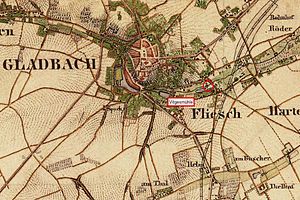Vitgesmühle
| Vitgesmühle
|
||
|---|---|---|
|
The Vitgesmühle on the original cadastral map |
||
| Location and history | ||
|
|
||
| Coordinates | 51 ° 11 '32 " N , 6 ° 26' 23" E | |
| Location |
|
|
| Waters | Gladbach | |
| Built | First mentioned in 1183 | |
| Shut down | 1886 demolished | |
| technology | ||
| use | Flour mill | |
| Grinder | 1 grind | |
| drive | 1 water wheel | |
| water wheel | overshot | |
The Vitgesmühle was a water mill with an overshot water wheel on the Gladbach in the city of Mönchengladbach .
geography
The Vitgesmühle was located on the left side of the Gladbach, at today's intersection between Lüpertzender Straße and Berliner Platz. In front of the mill was a mill pond on the right side of the Gladbach. The Flieschermühle was located above, the Krallsmühle below . The area on which the mill building stood has a height of approx. 55 m above sea level .
Waters
The Gladbach, (GEWKZ 28614), which is also the namesake of the city of Mönchengladbach, has been an important lifeline for centuries. It supplied the residents and a total of eight mills with water and was the origin of the flourishing textile industry in Mönchengladbach. The approximately 6.3 km long Gladbach rises in Waldhausen , crossed the districts of Pesch and Lürrip and flowed into the Niers at Uedding . Today it is mostly piped and flows from Volksbadstrasse at 1,904 m as an open channel along the Mönchengladbach – Düsseldorf railway line to the Niers. The catchment area of the body of water is 26.208 km 2 . The care and maintenance of the water is incumbent on NEW AG .
history
The Vitgesmühle was first mentioned in a document in 1183, when Abbot Walter II (1183–1190) acquired the mill and donated the proceeds to the monks' convent . It is the oldest documented mill in Mönchengladbach. The mill was also called Untere Mühle , Lingenmühle and Wolfkensmühle in the course of time . In the period around 1682/84, the then abbot Ambrosius Steingens had to leave the barn belonging to the Vitgesmühle to the Reformed for their services . This happened on the orders of the state and against the will of the abbot. With the secularization , the overshot mill came into private ownership. In 1886 the mill was stopped. The mill was demolished to make way for the imperial bath . Most of the grinding equipment was sold to Gierthmühle .
gallery
The Vitgesmühle on the Tranchot map 1803–1820
literature
- Hans Vogt: Lower Rhine water mill guide , 2nd edition. Niederrhein Association, Krefeld 1998, ISBN 3-00-002906-0 , pp. 499-500.
- Robert Lünendonk: On the trail of the Gladbach and its mills . 2008, ISBN 3-8375-0030-6 , 1st edition, p. 59.
- Robert Lünendonk: The Niers and their mills . 2012, ISBN 978-3-8375-0741-6 , pp. 66-70.
Web links
Individual evidence
- ^ German basic map 1: 5000
- ↑ http://www.lanuv.nrw.de/fileadmin/lanuv/wasser/pdf/Gewaesserverzeichnis%20GSK3C.xls







